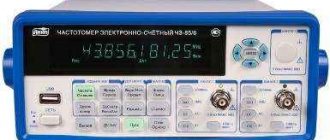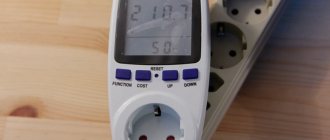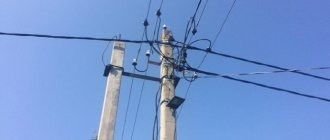What is a pulse counter?
A pulse counter is a serial digital device that stores a word of information and performs a counting micro-operation on it, which consists of changing the value of a number in the counter to 1. Essentially, the counter is a set of triggers connected in a certain way. The main parameter of the counter is the counting module. This is the maximum number of single signals that can be counted by the counter. Counters are designated by ST (from the English counter).
Summing pulse counter
Let's consider a summing counter (Fig. 3.67, a). Such a counter is built on four JK flip-flops, which, if there is a logical signal “1” at both inputs, switch when negative voltage drops appear at the synchronization inputs.
Timing diagrams illustrating the operation of the counter are shown in Fig. 3.67, b. Xi denotes the counting module (pulse counting coefficient). The state of the left trigger corresponds to the least significant digit of the binary number, and the right one corresponds to the most significant digit.
In the initial state, all flip-flops are set to logical zeros. Each trigger changes its state only at the moment when it is affected by a negative voltage drop.
Thus, this counter implements the summation of input pulses. From the timing diagrams it can be seen that the frequency of each subsequent pulse is two times less than the previous one, that is, each trigger divides the frequency of the input signal by two, which is used in frequency dividers.
How to install and connect?
The meter is installed as usual. The difference is in the connection of the wire for transmitting pulses. Where and how it is connected depends on the reading device. It is important that the meter and reader are compatible.
There are two connection methods:
- A relay circuit is the simplest connection option without any special advantages. This method is becoming obsolete, so it is better to pay attention to the next standard.
- NAMUR is an international standard that is used in many devices. Motion sensors, electricity/gas/heat meters are also connected in this way. The main advantages are versatility and wire break monitoring function. If the meter wire is damaged, the reading device will immediately notify the owner.
It's best if both connection options are supported. This will help avoid unnecessary expenses in the future if you have to change appliances.
Three-bit subtractor counter with serial carry
Let's consider a three-bit subtracting counter with sequential carry, the circuit and timing diagrams of which are shown in Fig. 3.68.
Vasiliev Dmitry Petrovich
Professor of Electrical Engineering, St. Petersburg State Polytechnic University
Ask a Question
The counter uses three JK flip-flops, each of which operates in T-flip-flop (flip-flop with counting input) mode.
Logic 1s are applied to the inputs J and K of each flip-flop, therefore, upon the arrival of the falling edge of the pulse supplied to its synchronization input C, each flip-flop changes the previous state. Initially, the signals at the outputs of all flip-flops are equal to 1. This corresponds to storing the binary number 111 or the decimal number 7 in the counter. After the end of the first pulse F, the first flip-flop changes state: the signal Q1 becomes equal to 0, and ¯Q1 − 1.
Vasiliev Dmitry Petrovich
Professor of Electrical Engineering, St. Petersburg State Polytechnic University
Ask a Question
The remaining triggers do not change their state. After the end of the second synchronization pulse, the first trigger changes its state again, moving to state 1 (Qx = 0). This ensures a change in the state of the second trigger (the second trigger changes state with some delay relative to the end of the second synchronization pulse, since its overturning requires time corresponding to the time of operation of itself and the first trigger).
After the first pulse F, the counter stores the state 11O. Further changes in the counter state occur in the same way as described above. After state 000, the counter goes back to state 111.
Advantages and disadvantages
Advantages:
- remote reading;
- possibility of automatic transfer to the management company;
- possibility of connecting additional systems (leakage control, water shut-off).
Flaws:
- sealed contact and wire are the most vulnerable parts. If any repair work is carried out near the meter, it is easy to break the wire with a careless movement;
- For full operation, it is necessary to install additional equipment: a reader or controller. Either the house must initially be connected to an automatic water metering system;
- if the reading device is dependent on electricity, then during a blackout it simply will not read the readings;
- Periodically it is necessary to check the dial readings with the value on the reading device. Even if there were no failures, small discrepancies may still occur. In this case, the readings on the reader must be changed manually.
Three-digit self-stopping subtracting counter with serial carry
Consider a three-bit self-stopping subtractive counter with sequential carry (Fig. 3.69).
After the counter transitions to state 000, a logical 0 signal appears at the outputs of all flip-flops, which is fed through an OR logic element to the inputs J and K of the first flip-flop, after which this flip-flop exits the T-flip-flop mode and stops responding to F pulses.
Model overview
Below is a small list of specific models with approximate prices.
For cold water
The choice of device model for cold water depends on many factors. We propose to consider the 3 best options, selected taking into account many parameters.
ITELMA WFK24.D080
Description: Dry type vane water meter. Maximum temperature 30°C. Withstands pressure of 10 bar.
Price: 1,000 rub.
Heat and water meter VSKhd-15-02
Description: Dry type vane water meter. Maximum temperature 30°C. Withstands pressure of 10 bar.
Price: 1,000 rub.
Economy MSV-15-165+KMCH
Description: Wet flow multi-jet counter. Operating temperature – up to 50°C. Withstands pressure of 16 bar.
Price: 1,800 rub.
For DHW
When choosing a hot water device, it is important to consider its reliability and durability, as well as what maximum temperature it can withstand. Let's consider the 2 most successful options.
ITELMA WFW24.D080
Description: Dry type vane hot water meter. Maximum temperature 90°C. Withstands pressure of 10 bar. One of the simplest options.
Price: 1,000 rub.
Heat and water meter VSGd-20
Description: More expensive option. This device can withstand temperatures up to 95°C, pressure up to 16 bar.
Price: 2,500 rub.
Zenner MTW-I DN32 Q6 L260
Description: High precision multi-jet counter. Shows correct readings even with long-term use: nominal and maximum flow rates are 6 and 12 m3/hour. Operating temperature – up to 95°C, maximum pressure – 16 bar.
Price: 6,000 rub.
Three-bit up/down counter with serial carry
Consider a three-bit up/down counter with sequential carry (Fig. 3.70).
In subtraction mode, the input signals must be applied to the TV input. In this case, a logical 0 signal is supplied to the Tc input. Let all flip-flops be in state 111. When the first signal arrives at the Tv input, a logical 1 appears at the T input of the first flip-flop, and it changes its state. After this, a logical 1 signal appears at its inverse input.
When the second pulse arrives at the TV input, a logical 1 will appear at the input of the second trigger, so the second trigger will change its state (the first trigger will also change its state upon the arrival of the second pulse). Further changes in state occur in a similar way. In addition mode, the counter operates similarly to a 4-bit adding counter. In this case, the signal is supplied to the Tc input. A logical 0 is supplied to the TV input. As an example, let’s consider up/down counter microcircuits (Fig: 3.71) with parallel transfer of the 155 series (TTL):
- IE6 - binary decimal up/down counter;
- IE7 is a binary up/down counter.
The counting direction is determined by which pin (5 or 4) the pulses are sent to. Inputs 1, 9, 10, 15 are informational, and input 11 is used for pre-recording. These 5 inputs allow pre-recording to the counter (preset). To do this, you need to submit the appropriate data to the information inputs, and then apply a low-level write pulse to input 11, and the counter will remember the number.
Input 14 is the O setting input when a high voltage level is applied. To build counters of larger capacity, forward and reverse transfer outputs are used (pins 12 and 13, respectively). From pin 12 the signal should be fed to the forward counting input of the next stage, and from pin 13 to the downward counting input.
When should you buy?
Apartment with a building-wide system for collecting readings .
In such houses, during construction, connectors for connecting pulse meters were installed. Therefore, you don’t have to buy additional equipment and bother setting it up. You just need to connect the meters, and the readings will be transmitted to the management company automatically.- "Smart House . Data from all meters is collected in the home management system. It will automatically transmit the testimony, or remind you to do it manually if the Criminal Code does not provide such an opportunity.
- Cottage and country house. There are several use cases here.
- If you forget to take instrument readings, you will have to travel out of town again, or pay for water consumption according to the standard. Remote readings will solve this problem.
- The water meter is installed in an inconvenient place - a basement, on the street, or simply a hard-to-reach place. In this case, you can move the display with data to a convenient room.
- You can install a system to monitor water leaks. Very useful for houses where no one lives for a long time.
Device structure
The device is an electronic computer with built-in pulse sensors (actions, cyclic repetitions of a mechanical type).
The device has a digital display that displays the amount of information processed by counting pulses and commands.
Impulses are considered to be the output of a unit of finished product, the completion of a cycle of production machines, and the receipt of an energy resource (in established units of measurement).
Manufacturers also offer combined digital instruments with expanded capabilities and an increased operating range.
Selection criteria
Before purchasing a device, you should pay attention to a number of parameters:
- Permissible current value. Digital models are designed for current 5-60A, which is suitable for apartments and private houses.
- Date of inspection. The three-phase meter must have a seal no older than 1 year.
- Number of fillings. The first sealing is done by government agencies - a mark is placed on the casing. The second seal on the clamp cover is from the power supply company.
- Optional. The more functions, the more expensive the meter. But the internal rater creates a load graph, and the event log notes the increase and decrease in voltage in each phase.
- Service and guarantees. High-quality models have a long warranty period. The brand's service center is located in the buyer's city.
- Check interval. Optimally – from 10 to 16 years.
The seller is obliged to stamp the device and record its starting readings.










